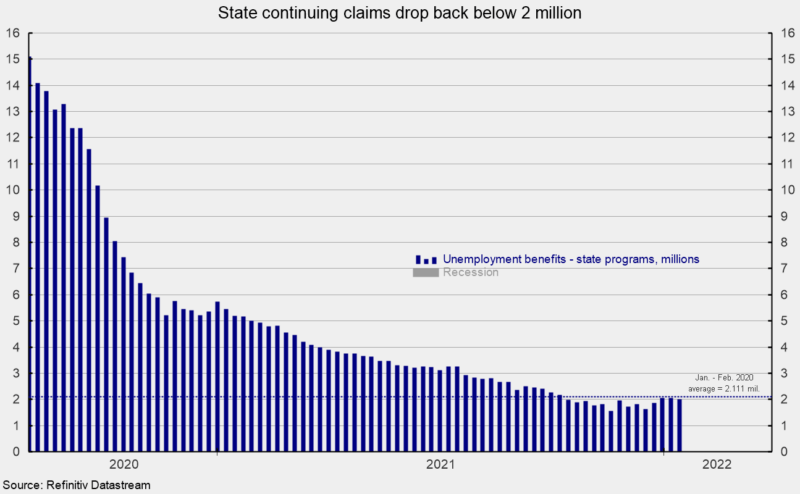Initial claims for regular state unemployment insurance decreased by 23,000 for the week ending January 29, coming in at 238,000 (see first chart). That is the second decline in a row but follows three consecutive increases that had pushed claims to a three-month high. Claims are still down in 11 of the last 18 weeks and by long-term historical comparison, remain very low.
The four-week average rose in the latest week – the fifth increase in a row and the sixth in the last seven weeks – coming in at 255,000, a rise of 7,750. Weekly initial claims data continue to suggest the labor market remains very tight.
The number of ongoing claims for state unemployment programs totaled 1.996 million for the week ending January 15, a drop of 63,461 from the prior week (see second chart). State continuing claims appear to be settling into a range near their pre-pandemic level of 2.111 million (see second chart).
Continuing claims in all federal programs totaled just 71,155 for the week ending January 15, a drop of 9,744. For January and February 2020, the average for Federal continuing claims was 34,174. Though the current numbers are above the pre-pandemic average, they are just a fraction of the 16.6 million peak and largely reflect the end of the emergency Pandemic Unemployment Assistance program and the Pandemic Emergency UC program.
The latest results for the combined Federal and state programs put the total number of people claiming benefits in all unemployment programs at 2.068 million for the week ended January 15, a drop of 73,205 from the prior week.
Despite some volatility over the last few weeks, initial claims remain at an extremely low level by historical comparison. The recent wave of new Covid cases may have been a contributing factor to the volatility over the last few weeks and remains a threat to the ongoing recovery in production. Still, the low level of claims combined with the high number of open jobs suggest the labor market remains very tight.
Continuing labor shortages, along with materials shortages and logistical issues, are likely to continue to hamper the recovery in production across the economy, though some recent data suggest businesses may be making some progress on reducing constraints on production.




